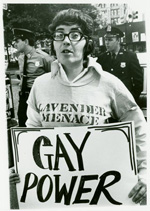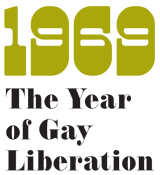Radicalesbians
 |
The Lavender Menace
"Ida," a member of the Gay Liberation Front and
the Lavender Menace, 1970. Photograph by Diana Davies.
NYPL, Manuscripts and Archives Division, Diana Davies Papers. Copyright Diana
Davies.
Digital ID: 1582182 |
Feminist author and activist Betty Friedan warned members of
the National Organization for Women (NOW) in 1969 of the "lavender
menace" threatening the women's movement. According to Friedan,
the presence of lesbians in the women's movement would destroy
the credibility of feminists, who would then be written off as
a bunch of "man-haters." A group of GLF women, including
author Rita Mae Brown and Karla Jay, decided to disrupt the Second
Congress to Unite Women in May 1970. They crashed the conference
wearing t-shirts emblazoned "LAVENDER MENACE" and distributed
copies of a manifesto entitled "The Woman Identified Woman." The
manifesto placed lesbianism at the center of feminist politics
as a political, cultural, and erotic resistance to patriarchy.
Feminism was never the same again. In the years that followed,
many feminists declared themselves "political lesbians" to
affirm their solidarity with lesbians and the centrality to their
personal and cultural work of a commitment to other women.
A cadre of these GLF women split off to form the Radicalesbians.
In these early years, many of these lesbian activists continued
to work closely with their gay peers, but in the later 1970s many
chose to work exclusively with other lesbian activists to create
woman-only spaces. These new spaces provided the ground for the
cultural and political work of lesbian feminism.

